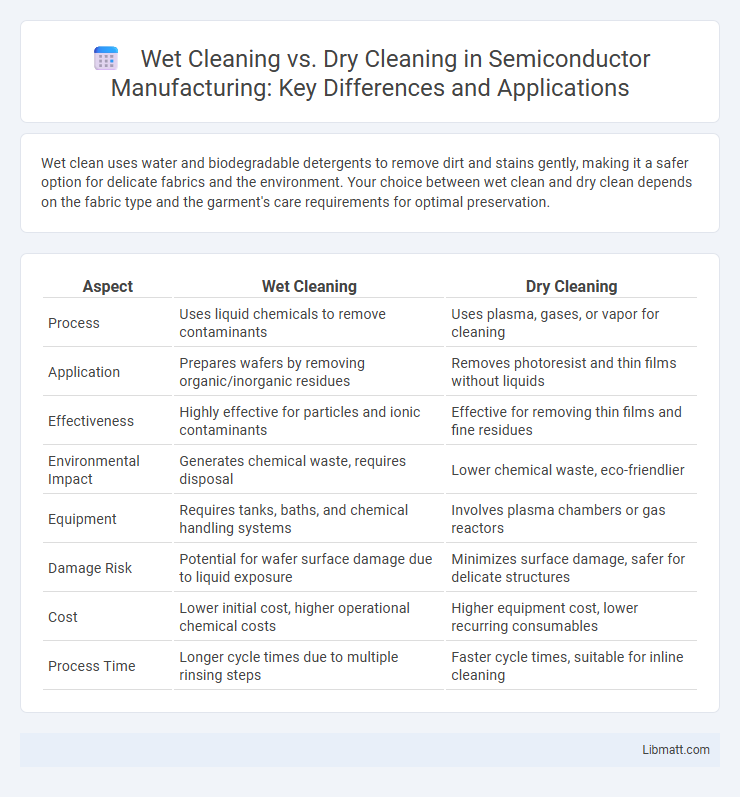Wet clean uses water and biodegradable detergents to remove dirt and stains gently, making it a safer option for delicate fabrics and the environment. Your choice between wet clean and dry clean depends on the fabric type and the garment's care requirements for optimal preservation.
Table of Comparison
| Aspect | Wet Cleaning | Dry Cleaning |
|---|---|---|
| Process | Uses liquid chemicals to remove contaminants | Uses plasma, gases, or vapor for cleaning |
| Application | Prepares wafers by removing organic/inorganic residues | Removes photoresist and thin films without liquids |
| Effectiveness | Highly effective for particles and ionic contaminants | Effective for removing thin films and fine residues |
| Environmental Impact | Generates chemical waste, requires disposal | Lower chemical waste, eco-friendlier |
| Equipment | Requires tanks, baths, and chemical handling systems | Involves plasma chambers or gas reactors |
| Damage Risk | Potential for wafer surface damage due to liquid exposure | Minimizes surface damage, safer for delicate structures |
| Cost | Lower initial cost, higher operational chemical costs | Higher equipment cost, lower recurring consumables |
| Process Time | Longer cycle times due to multiple rinsing steps | Faster cycle times, suitable for inline cleaning |
Introduction to Wet Clean and Dry Clean
Wet Clean employs water-based solutions and biodegradable detergents to safely clean delicate fabrics, minimizing chemical exposure and environmental impact. Dry Clean uses perchloroethylene or other solvents to remove stains and dirt without water, preserving fabric integrity and preventing shrinkage or distortion. Your choice between Wet Clean and Dry Clean depends on fabric type, stain nature, and environmental preferences for garment care.
What is Wet Cleaning?
Wet cleaning is an eco-friendly laundry method that uses water, specialized detergents, and computer-controlled machines to gently clean delicate fabrics without the harsh chemicals found in traditional dry cleaning. This process effectively removes dirt and stains while preserving garment quality and reducing environmental impact. Wet cleaning is ideal for textiles labeled "dry clean only" but sensitive to solvent-based cleaning.
What is Dry Cleaning?
Dry cleaning is a professional garment cleaning process that uses chemical solvents instead of water to remove dirt and stains. The most common solvent used is perchloroethylene (PERC), which effectively dissolves oils and grease from fabrics without causing shrinkage or color fading. This method is ideal for delicate materials like silk, wool, and chiffon that cannot withstand the agitation and moisture of traditional laundering.
Key Differences Between Wet and Dry Cleaning
Wet cleaning uses water and biodegradable detergents to remove stains, making it eco-friendly and gentle on delicate fabrics like silk and wool. Dry cleaning employs chemical solvents such as perchloroethylene to clean garments without water, effectively handling grease and oil-based stains on suits, coats, and structured garments. The primary differences lie in the cleaning agents, fabric compatibility, and environmental impact, with wet cleaning suitable for sensitive materials and dry cleaning preferred for tougher stains and heavier fabrics.
Environmental Impact: Wet Clean vs Dry Clean
Wet cleaning uses water and biodegradable detergents, significantly reducing harmful chemical waste compared to traditional dry cleaning solvents like perchloroethylene, which pose risks to air and water quality. This eco-friendly alternative lowers your carbon footprint by minimizing toxic emissions and hazardous waste disposal. Choosing wet cleaning supports sustainable garment care and protects both your health and the environment.
Effectiveness on Different Fabrics
Wet cleaning excels in gently removing water-soluble stains from delicate fabrics like silk, wool, and cashmere without causing shrinkage or damage. Dry cleaning uses chemical solvents to effectively dissolve oil-based stains on synthetic fibers, suits, and heavily soiled garments. Understanding the effectiveness of each method helps you choose the best cleaning process for preserving fabric integrity and appearance.
Stain Removal Comparison
Wet clean excels in removing water-based stains such as coffee, wine, and sweat due to its use of specialized detergents and controlled moisture, effectively breaking down and lifting stains without damaging delicate fabrics. Dry clean utilizes chemical solvents like perchloroethylene to target oil-based stains, grease, and ink, providing superior results on materials that cannot tolerate water. Your choice between wet clean and dry clean should depend on the type of stain and fabric care instructions to achieve optimal stain removal without compromising garment quality.
Cost Analysis: Wet Clean vs Dry Clean
Wet cleaning generally costs less than dry cleaning because it uses water and biodegradable detergents instead of expensive solvents like perchloroethylene. Dry cleaning prices often range from $5 to $20 per garment, influenced by fabric type and stain removal needs, whereas wet cleaning typically falls between $3 and $10 per item. Cost efficiency in wet cleaning is enhanced by lower energy consumption and reduced chemical disposal expenses, making it a budget-friendly and eco-conscious alternative.
Pros and Cons of Each Method
Wet cleaning uses water and specialized detergents, making it eco-friendly and effective for removing water-soluble stains but may shrink or damage delicate fabrics. Dry cleaning employs chemical solvents like perchloroethylene, ideal for delicate or structured garments without causing shrinkage but involves toxic substances and requires professional handling. Choosing between wet and dry cleaning depends on fabric type, stain nature, and environmental considerations.
Choosing the Right Cleaning Method for Your Needs
When selecting between wet clean and dry clean methods, consider fabric type, garment care labels, and sensitivity to moisture or chemicals. Wet cleaning uses water and biodegradable detergents, making it eco-friendly and ideal for washable, non-delicate fabrics, while dry cleaning employs chemical solvents suited for delicate, non-water-safe materials like silk or wool. Your choice ensures optimal garment longevity, appearance, and environmental impact, tailored to your specific clothing care requirements.
Wet Clean vs Dry Clean Infographic

 libmatt.com
libmatt.com